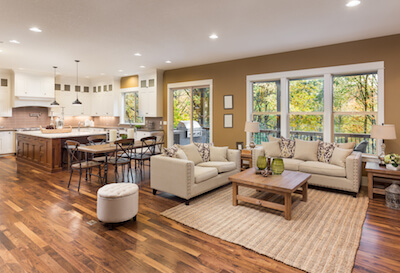Do You Know How Many Layers Your Floor Has?
Think your flooring has only one layer? Think again. Flooring is usually created in multiple layers to create a tighter, stronger structure. It also gives you the ability to change out the look easier if you tire of it, or it becomes damaged after years of wear.
Top Layer
This is the visible layer you walk on. It’s the layer everyone sees. 
Called a floor covering, it comes in many sizes and shapes, including ceramic tile, hardwood, vinyl, laminate, engineered wood, carpeting, and many others. Floor coverings are mainly used to provide aesthetics. Think of them as the clothing in your life. They dress up your surroundings while covering up the substrate – or the real floor underneath which has more permanence and structure.
Underlayment
The underlayment provides a smooth, consistent surface to install the floor covering.
This layer is optional and depends on the flooring cover chosen. For hardwood, it may be an underlayment of plywood. For tile and stone, a cement backer board may be needed to provide a solid base. Laminate flooring often gets a thin foam layer that rolls into place to deter the noise. Carpets get padding to add to the life.
Subfloor
The subfloor is the flat surface on which all other layers rest.
The subfloor is the bottom layer that rests on the joists. It’s made from plywood ranging in thickness from 19/32 to 1 ⅛ inch thick. The subfloor is structural, second only to joists to create the flooring of the home. It holds up all layers of flooring, as well as provide the support for everything you do in your home.
Joists
While not a true floor layer, joists are essential to the flooring system. They are structural and support everything else on top. Joists are made of engineered, laminated wood or lumber. Unless a home is built on a concrete slab, all houses have joists.
In rare circumstances, you may find a home with one layer of flooring. A stained concrete floor in the kitchen, for instance. You can also find multiple layers in older homes, where one layer after another is tacked down over time.
To find out how thick your floor covering is, there are several ways to find out.
Floor vents – removing an HVAC vent allows you have access to all layers
Top of the stairs – depending on how your staircase is installed, you may be able to have a cross-section view of the entire floor
Crawlspace or basement – this will give you a good view of the subfloor and can find out old construction methods
Closets or pantry – closets often don’t have baseboard molding and can allow you to peer down along the edge of the wall
